Blackbirds with white bellies add a striking contrast to the avian world, embodying nature’s elegant chiaroscuro.
Twelve distinct species, each with its unique plumage and lifestyle, stand out against the backdrop of diverse ecosystems.
From the intelligent and mischievous Black-billed Magpie to the nomadic resilience of the Snow Bunting, these avian characters weave a captivating narrative.
The ebony and ivory symphony they create tells tales of adaptation, survival, and the intricate dance of life.
Join us on an exploration of these black-feathered wonders, as we unveil the stories written in the contrasting hues that adorn their bellies, revealing the diversity and beauty of the avian tapestry.
In the following passages, we delve into the fascinating lives of these twelve black birds with white bellies, and triumphs that make each species a unique masterpiece in the grand composition of the natural world. Stay sharp.
12 Black Birds with White Bellies
In the avian realm, black birds with white bellies paint a striking contrast against nature’s canvas.
From the mischievous intelligence of the Black-billed Magpie to the nomadic resilience of the Snow Bunting, each species reveals a unique tale.
Join this feathered journey as we explore the lives of these captivating birds, woven with hues of ebony and ivory.
1. Black-billed Magpie (Pica hudsonia)
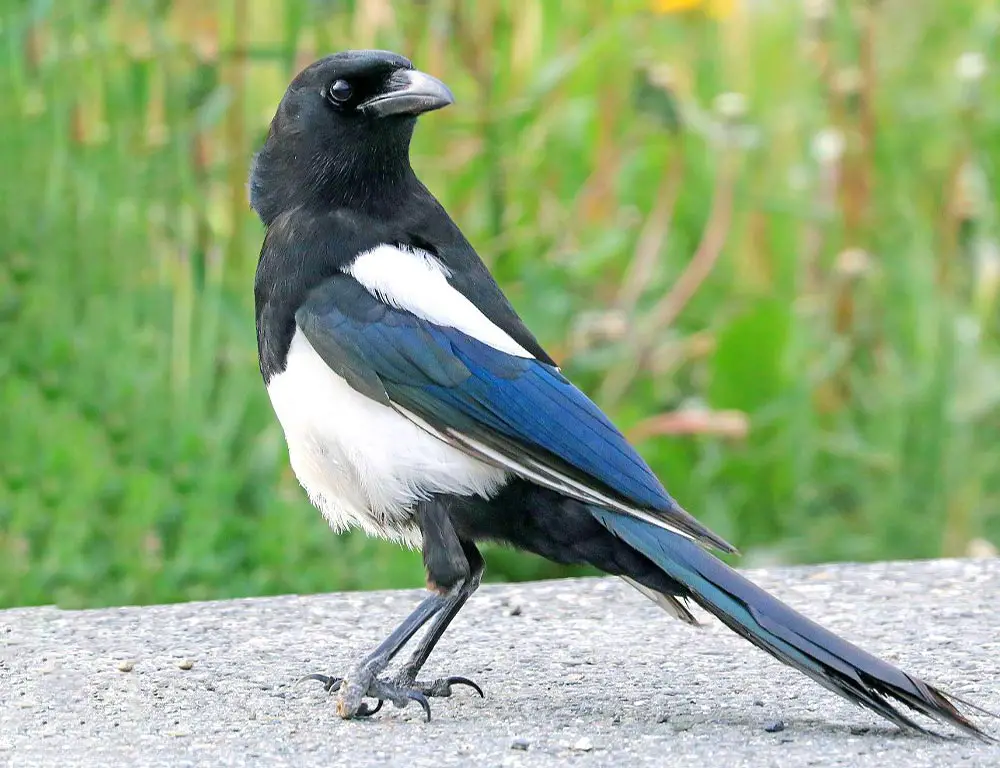
- Scientific name: Pica hudsonia
- Population: Common in western North America
- Life span: Up to 7-8 years
- Size: 18-24 inches in length
- Weight: 5-8 ounces
- Food: Omnivorous, diet includes insects, small animals, seeds, and fruits.
The Black-billed Magpie, with its striking black plumage and contrasting white belly, is a highly intelligent and adaptable bird.
Found in open country and urban areas, these magpies are known for their mischievous behavior and remarkable vocalizations.
Their omnivorous diet contributes to their survival in various environments. Magpies are opportunistic foragers, scavenging for food and occasionally preying on small animals.
Their communal lifestyle involves complex social structures and cooperative breeding.
2. Dark-eyed Junco (Junco hyemalis)
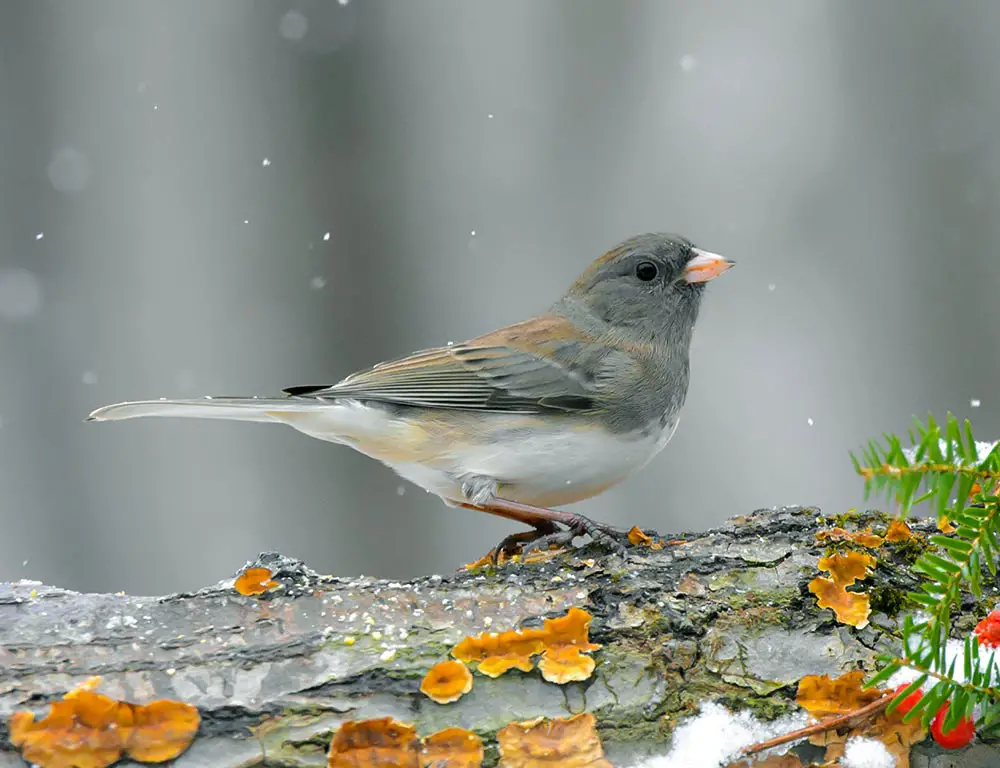
- Scientific name: Junco hyemalis
- Population: Widespread across North America
- Life span: 3-5 years
- Size: 5-6 inches in length
- Weight: 0.5-1 ounce
- Food: Primarily seeds and insects
The Dark-eyed Junco, characterized by its dark plumage and distinct white belly, is a migratory bird commonly found in various habitats. These small sparrows form loose flocks during the winter months.
Dark-eyed Juncos are primarily seed-eaters, with a diet consisting of seeds, insects, and berries.
Their nomadic lifestyle involves altitudinal migration, moving between higher elevations in summer and lower elevations in winter.
They are known for their ground-foraging behavior, frequently hopping and scratching for food on the forest floor.
3. Loggerhead Shrike (Garrulax leucolophus)
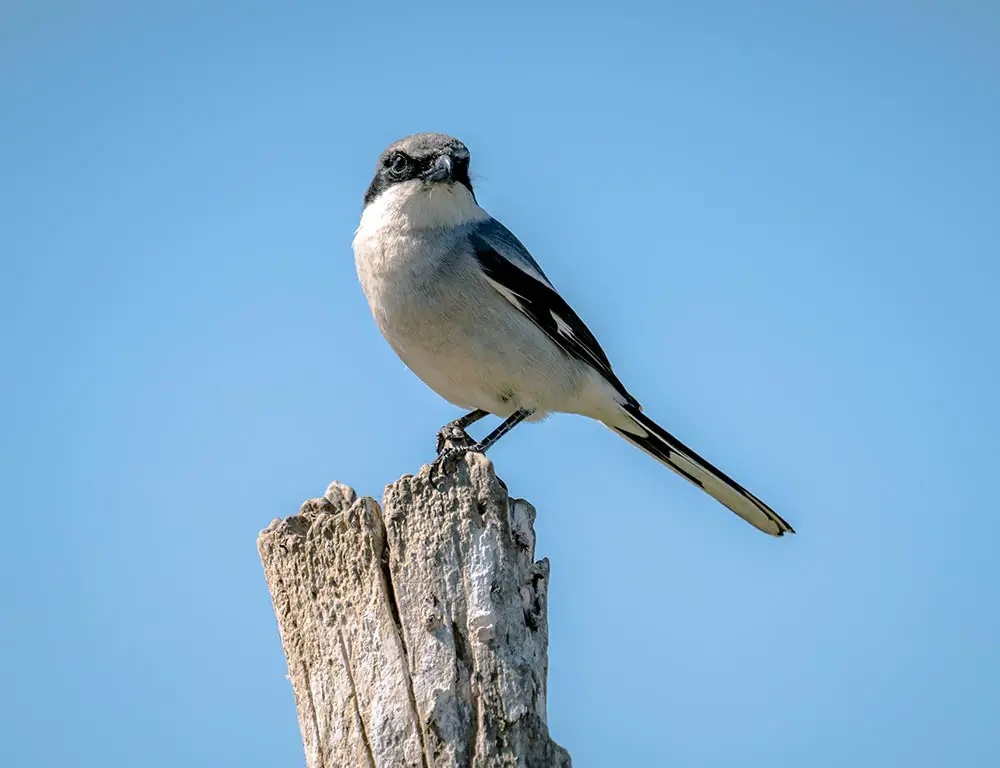
- Scientific name: Garrulax leucolophus
- Population: Found in South Asia
- Life span: 8-10 years
- Size: 8-10 inches in length
- Weight: 1-2 ounces
- Food: Carnivorous, preying on insects and small vertebrates
The Loggerhead Shrike, adorned with black and white plumage, is a predatory songbird known for its unique hunting behavior.
With a hooked bill, it impales its prey on thorns or barbed wire, creating a larder of food. Loggerhead Shrikes are territorial and often inhabit open landscapes with scattered trees.
Despite being songbirds, their melodious calls contrast with their predatory habits. Their efficient hunting skills contribute to their survival in a variety of ecosystems.
4. Black-and-White Warbler (Mniotilaira varia)
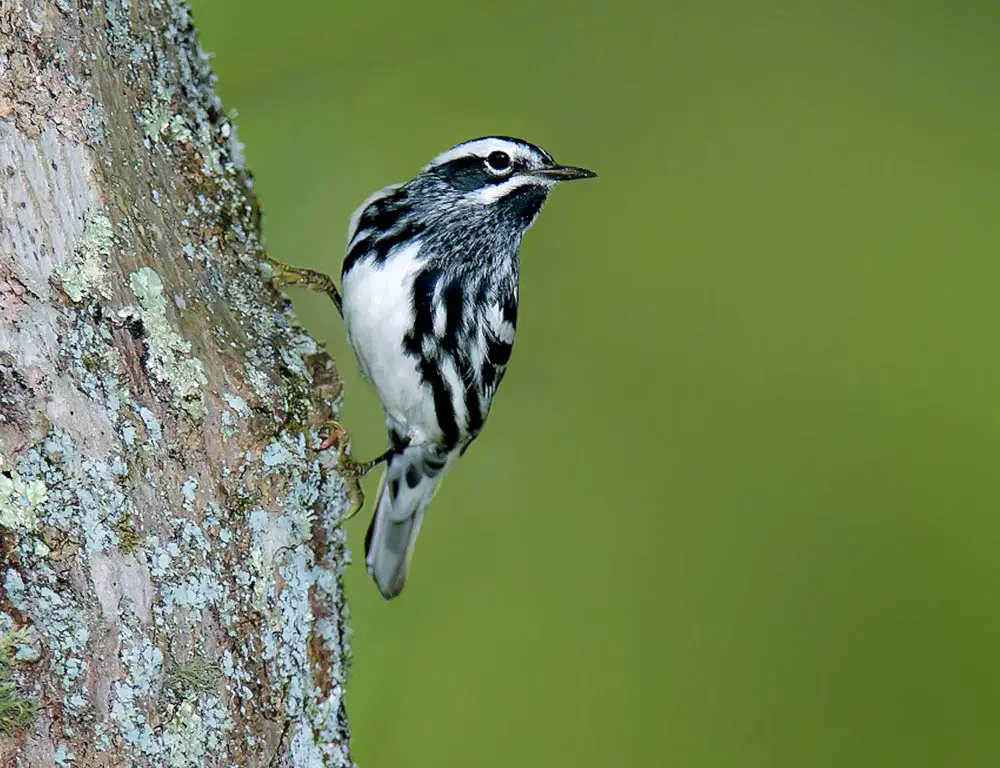
- Scientific name: Mniotilaira varia
- Population: Found in North and Central America
- Life span: 4-7 years
- Size: 4-5 inches in length
- Weight: 0.3-0.4 ounces
- Food: Insectivorous, feeding on insects and spiders
The Black-and-White Warbler, with its distinctive zebra-like black and white stripes, is a small but active bird that forages along tree trunks and branches.
These warblers are primarily insectivorous, gleaning insects and spiders from bark crevices and foliage. Their unique foraging behavior sets them apart from other warblers, as they move nimbly and vertically on tree trunks.
Known for their high-pitched songs, these birds prefer mature forests and are often observed in mixed-species flocks during migration.
5. Blackpoll Warbler (Setophaga striata)
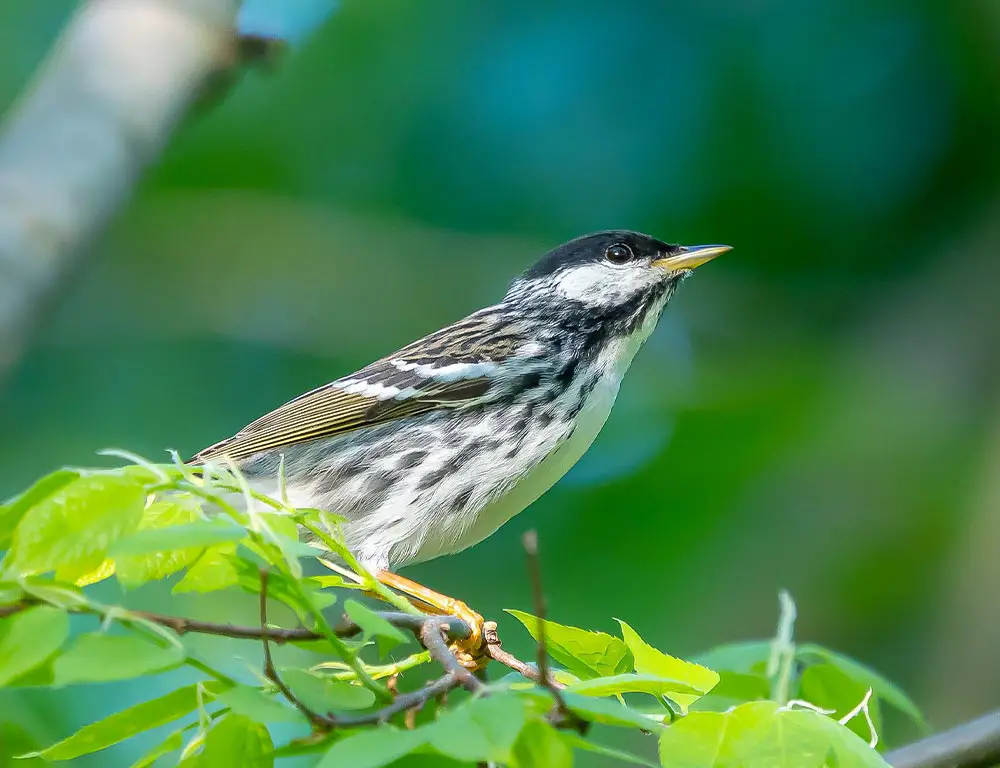
- Scientific name: Setophaga striata
- Population: Breeds in North America, migrates to South America
- Life span: 3-5 years
- Size: 4.7-5.5 inches in length
- Weight: 0.3-0.4 ounces
- Food: Primarily insectivorous, feeding on insects and spiders
The Blackpoll Warbler is a small migratory bird with striking black and white plumage. During the breeding season, males display a black cap, while females have a duller cap.
These warblers are known for their impressive long-distance migration, flying non-stop for up to 72 hours over the Atlantic Ocean. They breed in the boreal forests of North America and winter in South America.
Blackpoll Warblers forage actively for insects, spiders, and larvae, often in the canopy of trees. Their migratory feats and adaptability showcase their remarkable survival strategies.
6. Snow Bunting (Plectrophenax nivalis)
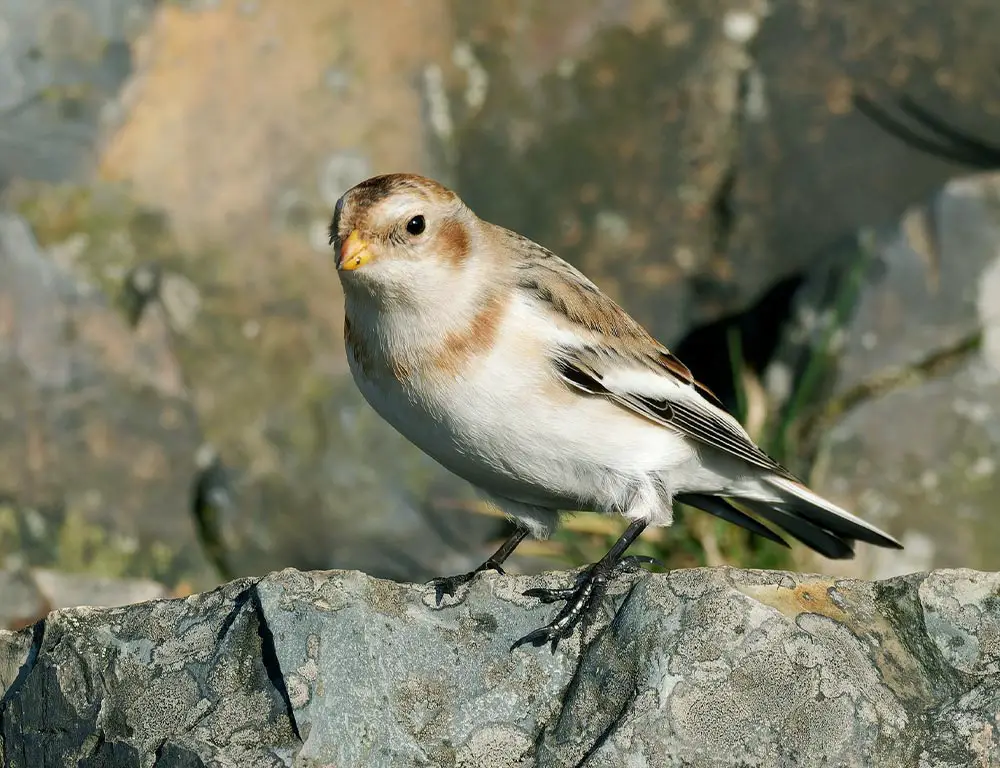
- Scientific name: Plectrophenax nivalis
- Population: Circumpolar Arctic and subarctic regions
- Life span: 4-6 years
- Size: 6.3-7.5 inches in length
- Weight: 1.2-2 ounces
- Food: Herbivorous, feeding on seeds and insects
The Snow Bunting, with its black and white plumage, is a hardy bird adapted to cold, snowy environments.
During the breeding season, males display striking white plumage, while females and non-breeding individuals have more subdued coloring.
Snow Buntings primarily feed on seeds, especially during the winter months, but also consume insects during the breeding season.
They are well-adapted to harsh Arctic conditions and have a nomadic lifestyle, moving in search of food. Their appearance and behavior are iconic of the northern tundra landscapes they inhabit.
7. Northern Mockingbird (Mimus polyglottis)
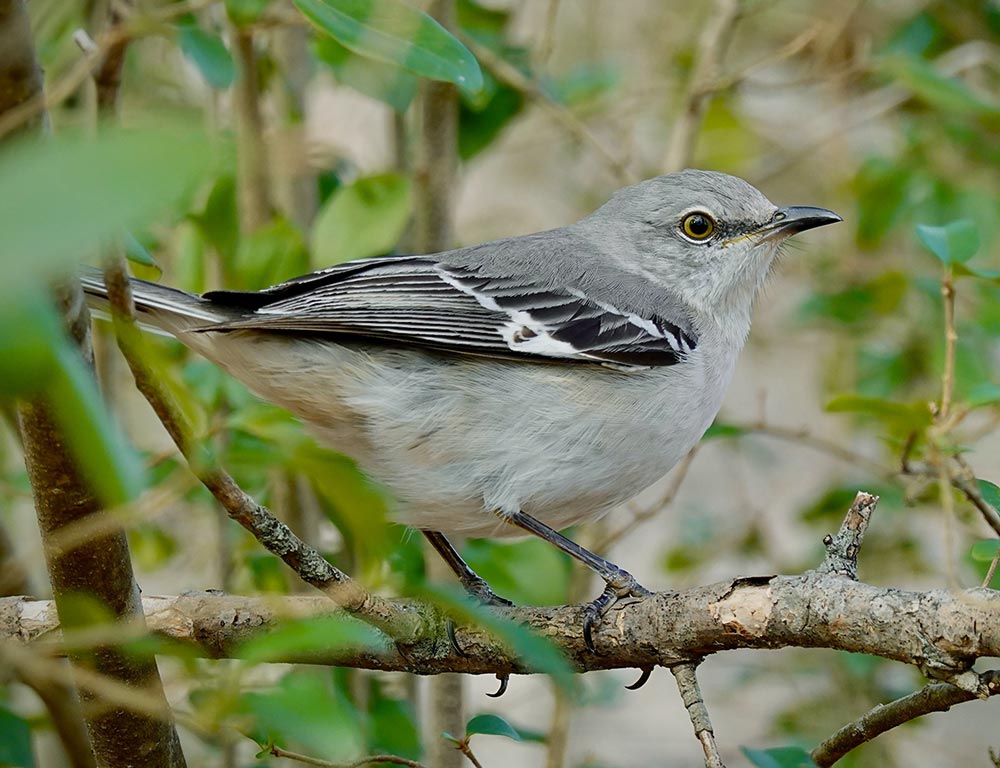
- Scientific name: Mimus polyglottis
- Population: Found in North America
- Life span: 8-10 years
- Size: 8-10 inches in length
- Weight: 1.6-2 ounces
- Food: Omnivorous, feeding on insects, fruits, and berries
The Northern Mockingbird, with its black and white wing bars, is a highly vocal and adaptable bird.
Known for its impressive mimicry of other bird species and even mechanical sounds, the Northern Mockingbird is a versatile songster. These birds are omnivorous, feeding on insects, fruits, and berries.
They are territorial and often defend their feeding areas vigorously. Their ability to thrive in urban as well as natural environments highlights their adaptability and resilience.
8. Black-capped Chickadee (Poecile atricapillus)
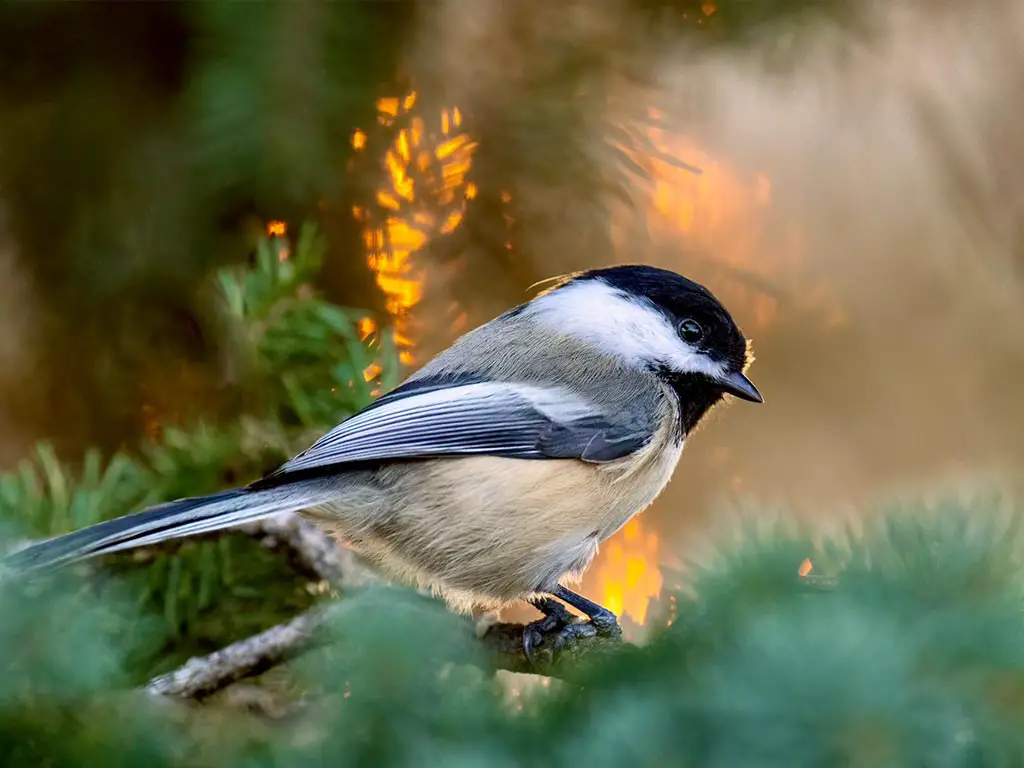
- Scientific name: Poecile atricapillus
- Population: Found in North America
- Life span: 6-10 years
- Size: 4.7-5.9 inches in length
- Weight: 0.3-0.5 ounces
- Food: Omnivorous, feeding on seeds, insects, and berries
The Black-capped Chickadee is a small and charismatic bird with a distinctive black cap and bib. These social birds are often found in mixed-species flocks.
Black-capped Chickadees have a varied diet, feeding on seeds, insects, and berries.
Known for their acrobatic foraging behavior, they are capable of hanging upside down to extract insects from bark.
Their unique “chick-a-dee-dee-dee” call is not only a form of communication but also serves as an alarm signal, indicating the presence of predators.
Despite their small size, Black-capped Chickadees exhibit remarkable intelligence and adaptability in their environment.
9. White-breasted Nuthatch (Sitta carolinensis)
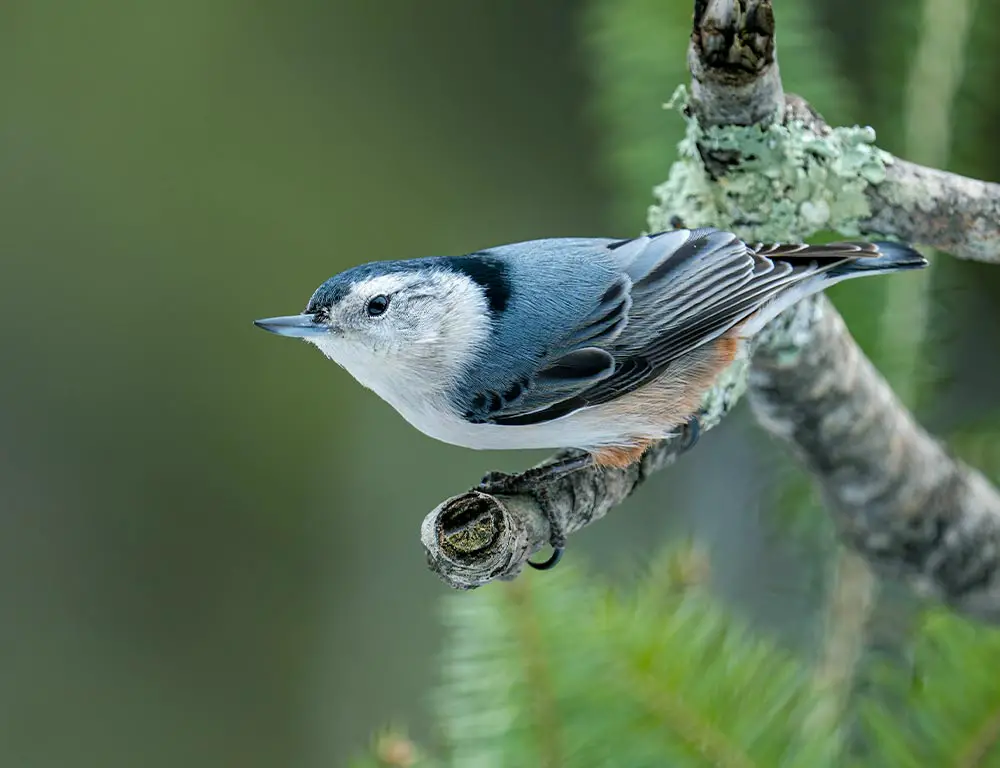
- Scientific name: Sitta carolinensis
- Population: Widespread in North America
- Life span: 2-3 years
- Size: 5.5-6 inches in length
- Weight: 0.6-1 ounce
- Food: Insectivorous, feeding on insects, spiders, seeds, and nuts
The White-breasted Nuthatch is a compact and agile bird easily identified by its distinctive black cap, white face, and chestnut-colored undertail.
These nuthatches are known for their unique head-first descent down tree trunks and branches.
They have a diverse diet, consuming insects, spiders, seeds, and nuts. White-breasted Nuthatches are often found in deciduous and mixed woodlands, using their strong bills to pry insects from bark crevices.
Their adaptable foraging techniques and sociable behavior, often seen in pairs or family groups, contribute to their success in various North American habitats.
10. Black Phoebe (Sayornis nigricans)
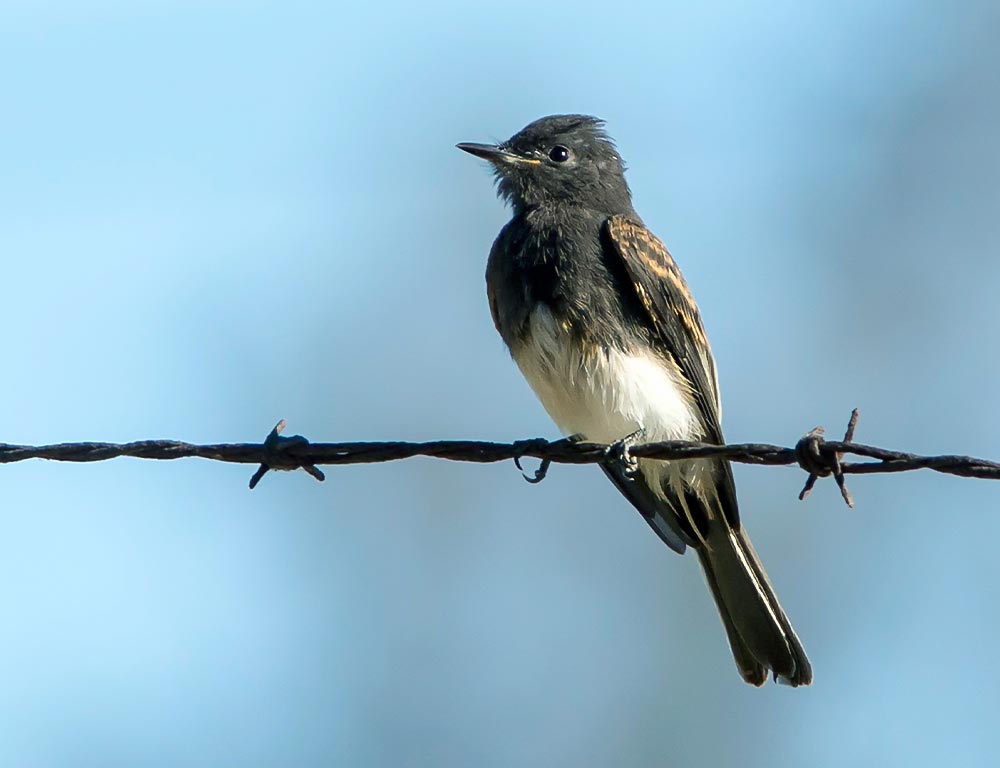
- Scientific name: Sayornis nigricans
- Population: Western North America to South America
- Life span: 3-5 years
- Size: 6-7 inches in length
- Weight: 0.7-1 ounce
- Food: Insectivorous, feeding on insects caught in mid-air and on surfaces
The Black Phoebe is a sleek, black and white flycatcher with a distinctive habit of perching conspicuously near water. With a constant tail-wagging motion, they hunt for insects on the wing or from perches.
Black Phoebes have a wide distribution, ranging from western North America to South America. Their reliance on aquatic habitats, such as streams and ponds, for both foraging and nesting, sets them apart.
Their adaptability to urban environments and ability to catch a variety of flying insects make them successful and conspicuous members of their ecosystems.
11. Eastern Kingbird (Tyrannus tyrannus)
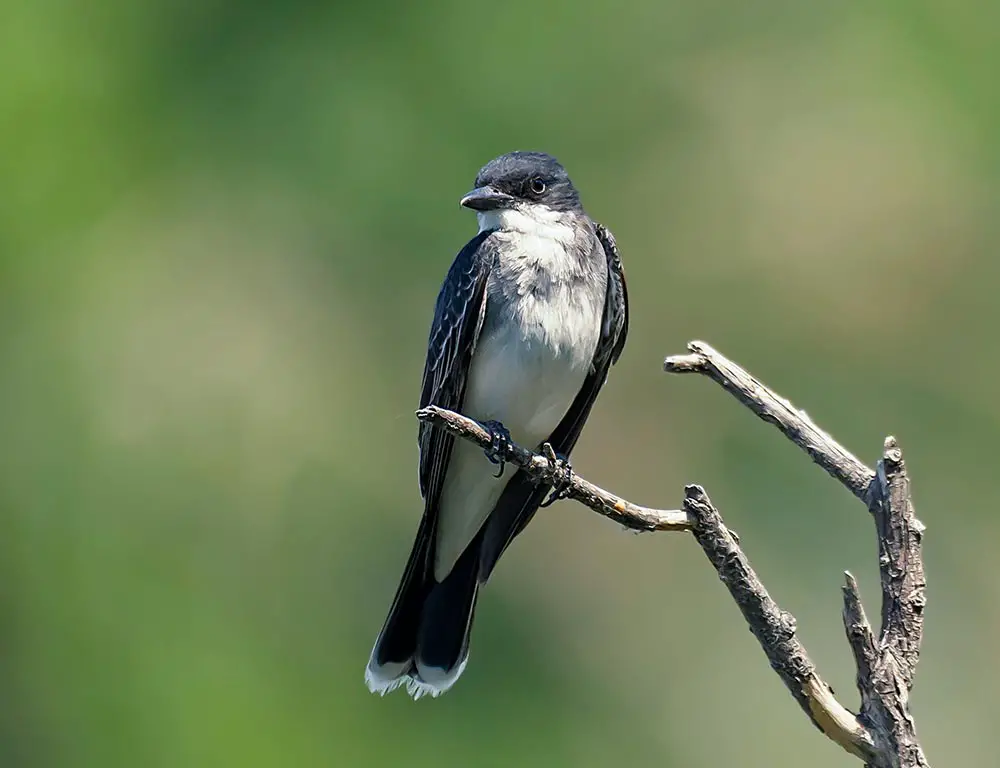
- Scientific name: Tyrannus tyrannus
- Population: Found in North and South America
- Life span: 7-10 years
- Size: 7.5-9 inches in length
- Weight: 1.3-1.8 ounces
- Food: Insectivorous, feeding on flying insects
The Eastern Kingbird is a medium-sized flycatcher with black and white plumage, a distinctive white-tipped tail, and a concealed red crown.
Known for their aggressive behavior, especially during the breeding season, Eastern Kingbirds fearlessly defend their territory against larger birds.
They primarily feed on flying insects, catching them in mid-air with acrobatic maneuvers. Eastern Kingbirds are often found near open fields and grasslands where they perch on exposed branches, fences, or utility wires.
Their boldness and aerial prowess contribute to their success in a wide range of North and South American habitats.
12. Carolina Chickadee (Poecile carolinensis)
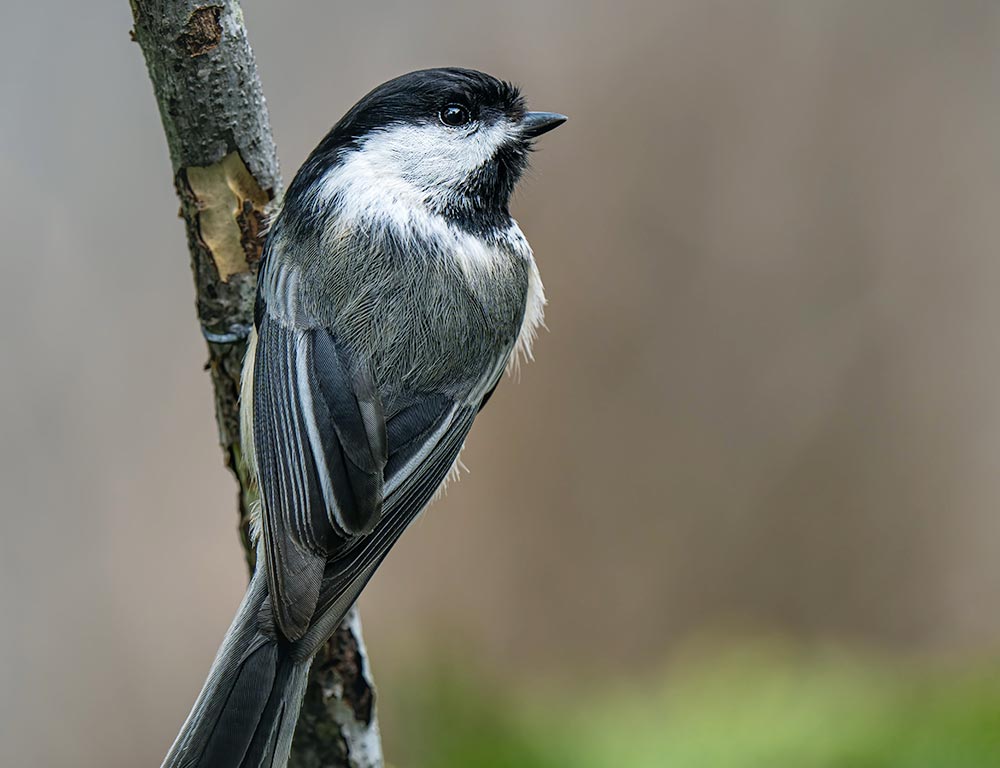
- Scientific name: Poecile carolinensis
- Population: Southeastern United States
- Life span: 2-3 years
- Size: 4-5 inches in length
- Weight: 0.3-0.5 ounces
- Food: Omnivorous, feeding on insects, seeds, and berries
The Carolina Chickadee is a small, vocal bird with a distinctive black cap, white cheeks, and a soft gray back.
These social and adaptable birds are often found in mixed-species flocks and are known for their “chick-a-dee-dee-dee” calls.
Carolina Chickadees have an omnivorous diet, feeding on insects, seeds, and berries. They are agile foragers, exploring various parts of trees and shrubs in search of food.
Their ability to adjust to urban environments and their year-round lively behavior make them a familiar and welcomed presence in the southeastern United States.
Wrapping Up
In the diverse symphony of nature, black birds with white bellies showcase resilience, adaptability, and unique survival strategies.
From the magpies’ communal intellect to the warblers’ migratory feats, these birds enrich ecosystems and captivate observers.
Their tales echo the intricate dance between plumage and behavior, revealing the profound stories written in the skies. Thank you.
